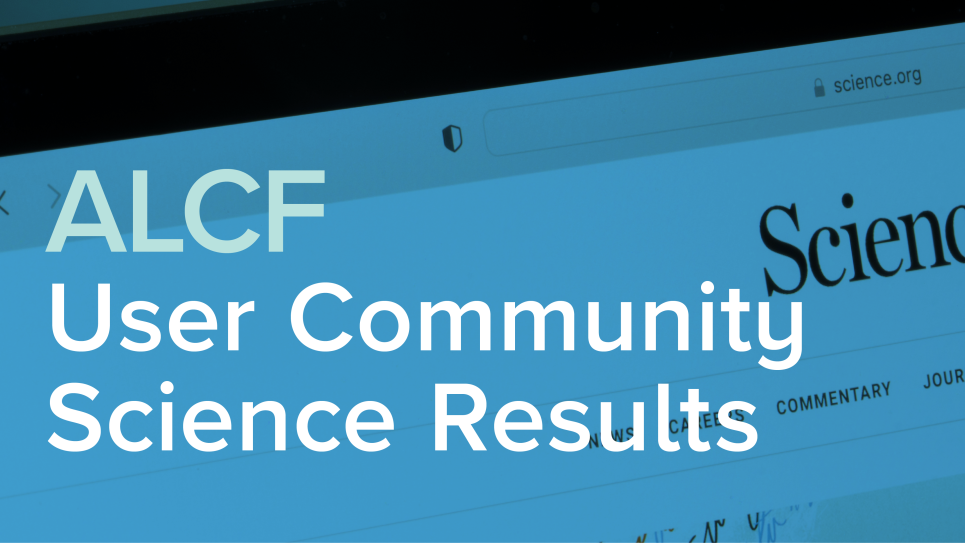
ALCF User Results: Recent publications cover chemistry, drug discovery, and drought predictions
Using supercomputing resources at the ALCF, researchers produce a number of impactful studies and publications across scientific domains.
The ALCF user community continually pushes the boundaries of scientific computing, producing groundbreaking studies in areas ranging from chemistry and engineering to physics and materials science. Below, we highlight some of the recent results published by ALCF users.
“Photoelectron Spectra of Water and Simple Aqueous Solutions at Extreme Conditions,” Faraday Discussions
ALCF principal investigator (PI): Giulia Galli, University of Chicago and Argonne National Laboratory
Determining the electronic structure of aqueous solutions at extreme conditions is an important step toward understanding chemical bonding and reactions in water subjected to pressure and high temperatures. Combining first-principles and deep-potential molecular dynamics with electronic structure calculations with dielectric-dependent hybrid functionals, the authors used ALCF resources to calculate the photoelectron spectra of water and a simple solution of sodium chloride under pressure at conditions relevant to the Earth’s interior.
“Alchemical Free Energy Estimators and Molecular Dynamics Engines: Accuracy, Precision and Reproducibility,” Journal of Chemical Theory and Computation
ALCF PI: Peter Coveney, University College London
The binding free energy between a ligand and its target protein is an essential quantity during all stages of the drug discovery process, its computation offering insight into where efforts should be focused in the pursuit of effective therapeutics to treat a myriad of diseases. In this paper, the authors leveraged Theta and ThetaGPU to examine the computation of alchemical relative binding free energies with an eye for assessing reproducibility across popular molecular dynamics packages and free energy estimators, focusing on 54 ligand transformations from a diverse set of protein targets.
“Projected U.S. Drought Extremes through the Twenty-First Century with Vapor Pressure Deficit,” Scientific Reports
ALCF PI: Rao Kotamarthi, Argonne National Laboratory
Global warming is expected to enhance drought extremes in the U.S. throughout the twenty-first century. Projecting these changes can be complex in regions with atmospheric and soil moisture that exhibit high variability on small spatial scales. Vapor Pressure Deficit (VPD) is a valuable measure of evaporative demand as moisture moves from the surface into the atmosphere and a dynamic measure of drought. In this paper, Argonne researchers use VPD to identify short-term drought with the Standardized VPD Drought Index and to characterize future extreme, and they develop random sampling technique to quantify multimodel uncertainties.
“Machine Learning the Metastable Phase Diagram of Covalently Bonded Carbon," Nature Communications
ALCF PI: Subramanian Sankaranarayanan, Argonne National Laboratory
Conventional phase diagram generation involves experimentation to provide an initial estimate of the set of thermodynamically accessible phases and their boundaries, followed by use of phenomenological models. Such an approach, combined with high throughput first-principles calculations and data-mining techniques, has led to exhaustive thermodynamic databases, albeit focused on the reduced set of phases observed at distinct thermodynamic equilibria. In contrast, materials during their synthesis, operation, or processing, may not reach their thermodynamic equilibrium state, but instead remain trapped in a local (metastable) free energy minimum, which may exhibit desirable properties. In this paper, the authors utilize ALCF resources to introduce an automated workflow that integrates first-principles physics and atomistic simulations with machine learning and high-performance computing to allow rapid exploration of the metastable phases to construct “metastable” phase diagrams for materials far-from-equilibrium.
The ALCF is a U.S. Department of Energy (DOE) user facility located at DOE’s Argonne National Laboratory.
If your team has a recent publication that used ALCF resources, please let us know by contacting us at pubs@alcf.anl.gov.